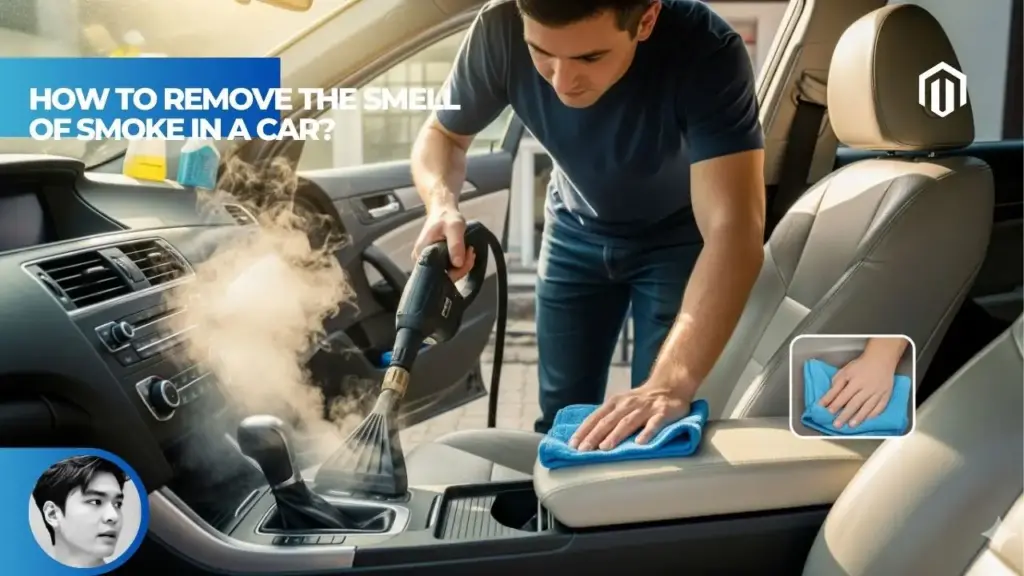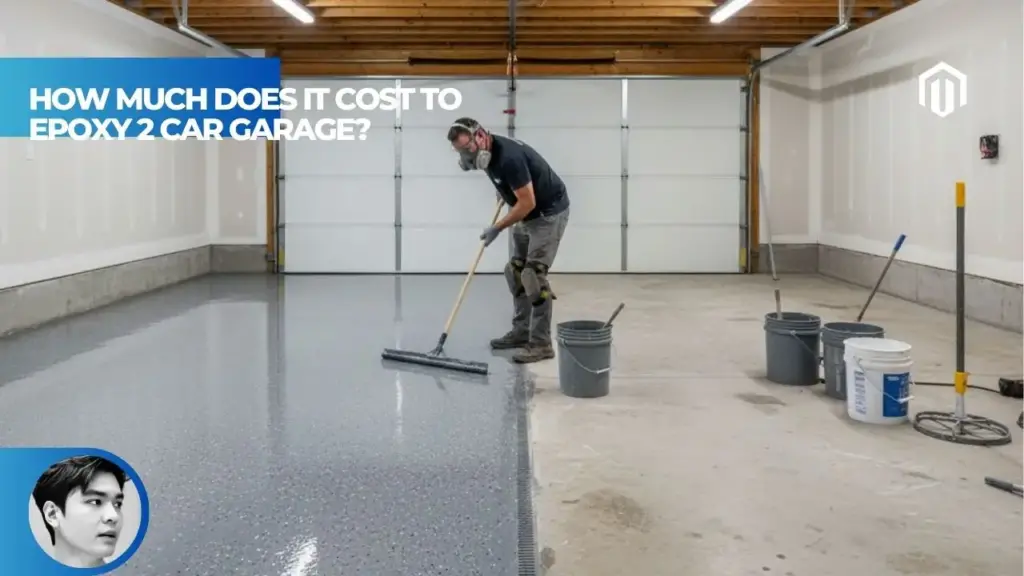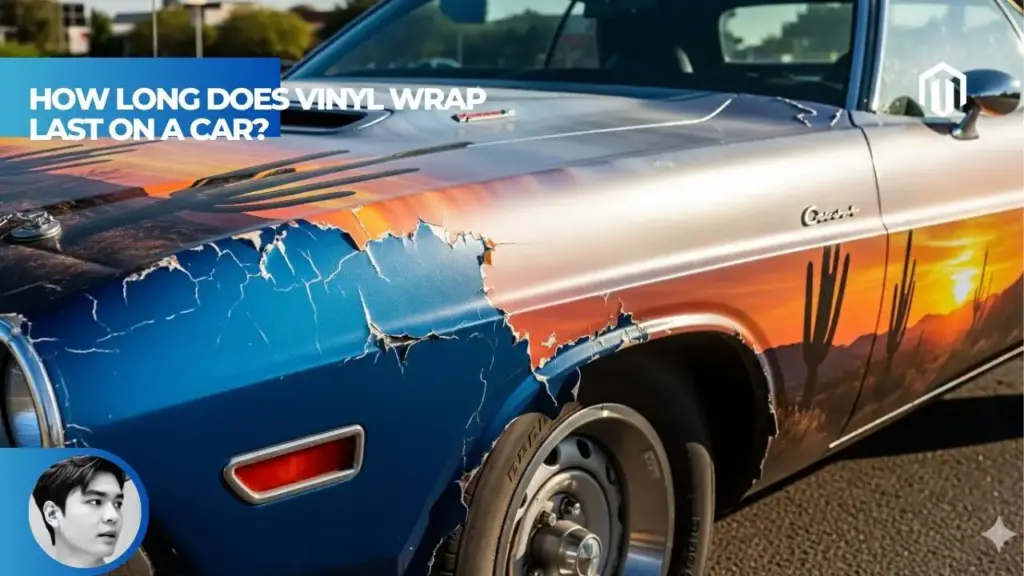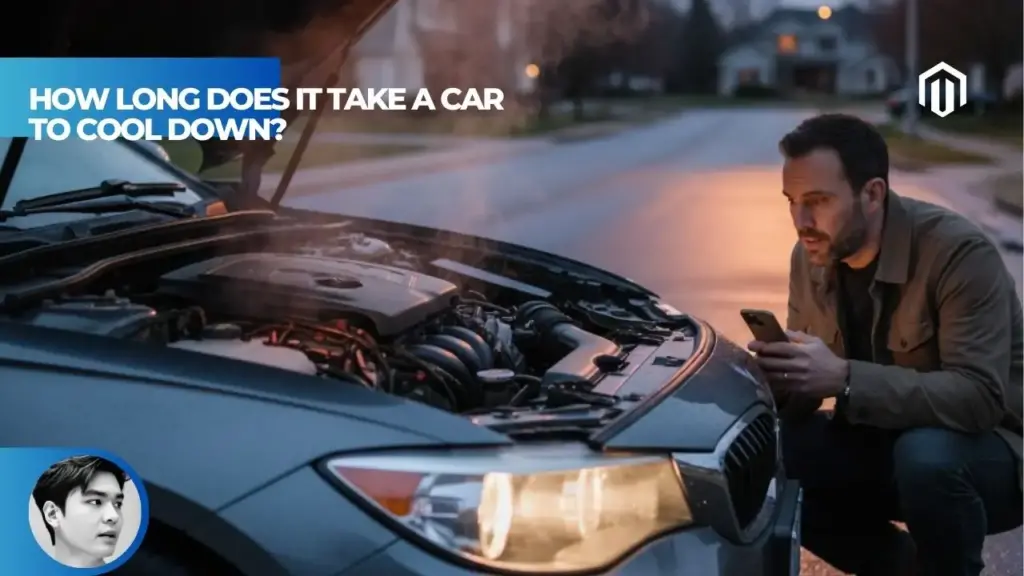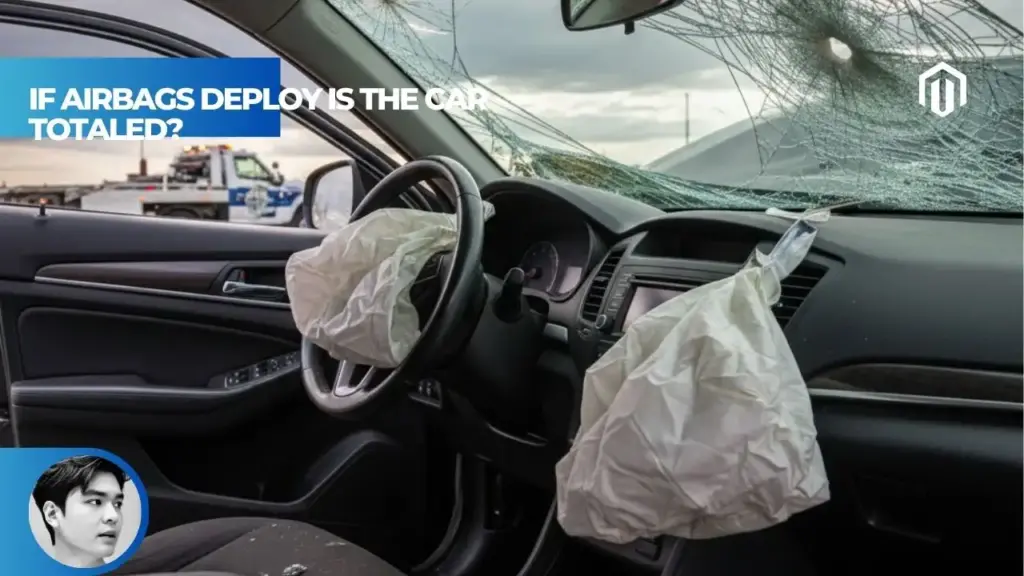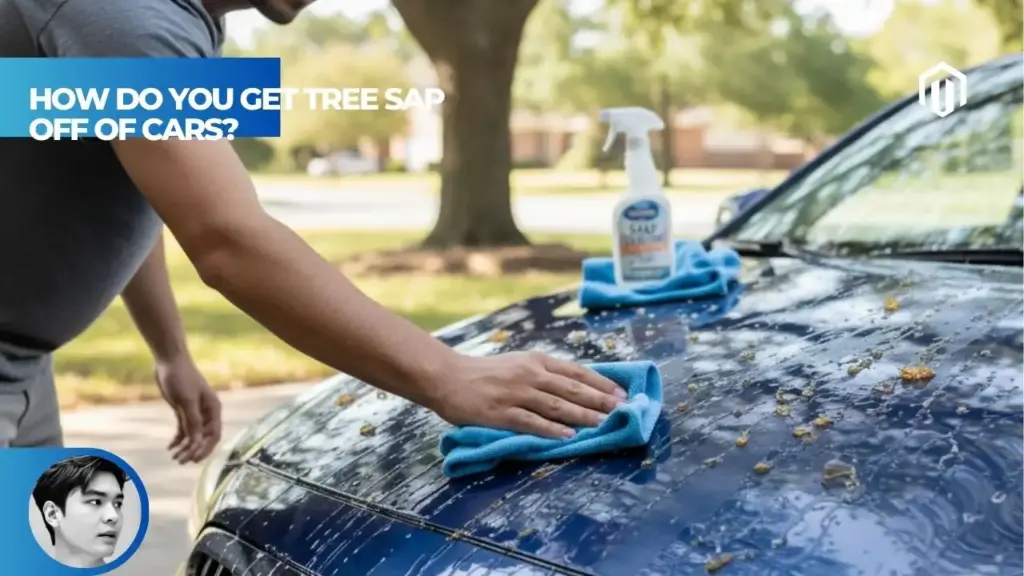You may also like:
- 【Explained】How to Get Pot Smell Out of a Car? Your Complete DIY Guide
- 【Review】Top 7 Best Ways to Clean a Car After a Body Repair
- 【Explained】When Does the 2-Hour Car Seat Rule End for Babies?
- 【Explained】How to Fix Car AC Blowing Hot Air? DIY Troubleshooting Guide
- 【Explained】Where Is the Expiration Date on a Car Seat?
To permanently remove smoke smell from your car, you need a systematic approach: deep clean all surfaces, neutralize absorbed odors with baking soda or vinegar, replace the cabin air filter, and consider ozone treatment for stubborn smells. Simply masking the odor with air fresheners won’t work—you must eliminate smoke particles embedded in fabrics, plastics, and the ventilation system[1].
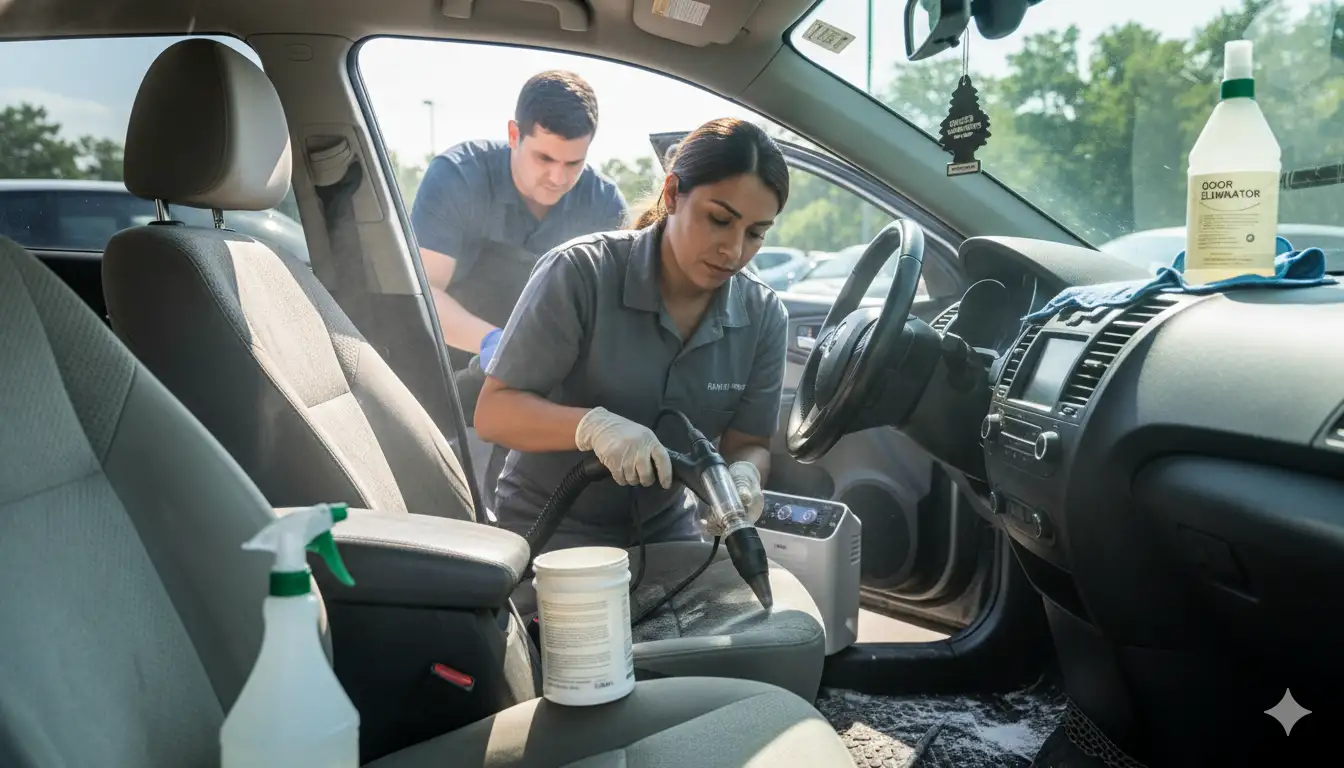
Understanding Smoke Damage and Odor Sources
Smoke odor in vehicles presents unique challenges because tobacco tar and nicotine particles penetrate deeply into porous materials. According to Autvex’s detailing experts, successful odor removal requires understanding where smoke hides and why conventional cleaning often fails.
Where Does the Smoke Smell Hide in a Car?
Smoke particles infiltrate every porous surface in your vehicle’s interior. The microscopic tar and nicotine molecules bond chemically with materials, creating persistent odors that resist basic cleaning. Professional detailers report finding concentrated smoke residue in overlooked areas months after initial cleaning attempts[2].
Primary smoke hiding spots include:
- Headliner fabric: Absorbs 40% more smoke than other surfaces
- Seat cushion foam: Traps particles deep within padding layers
- Carpet backing and underlay: Holds moisture and smoke residue
- Air conditioning evaporator core: Circulates trapped odors
- Dashboard vents and ductwork: Accumulates tar buildup
- Seat belt fabric: Often overlooked but heavily contaminated
- Door panel fabric inserts: Collects smoke near windows
The cabin air filter alone can harbor enough smoke particles to recontaminate a cleaned interior within days if not replaced.
Smoke Damage Car Odor Removal Challenges
Cigarette smoke creates a triple-layer contamination that makes removal particularly difficult. First, the visible tar film coats all surfaces. Second, nicotine crystals embed in fabrics. Third, chemical compounds penetrate plastic and vinyl at the molecular level.
Temperature variations worsen the problem—heat causes embedded particles to release more odor, while cold temporarily masks it. This explains why a car might smell fine in winter but reek in summer. Professional studies show that vehicles exposed to smoking for over six months require 70% more intensive treatment than those with recent contamination[3].
Old Smoke Smell in Used Car Considerations
Purchasing a used car with smoke odor presents additional challenges. Years of accumulated residue creates layers requiring progressive treatment. Dealers often use heavy fragrances to mask smells during sales, but these wear off within weeks, revealing the underlying problem.
Used car smoke issues typically involve:
- Multiple contamination layers from different smoking habits
- Degraded materials that absorbed more particles over time
- Previous failed cleaning attempts that pushed residue deeper
- Hidden damage in areas like spare tire wells or under seats
Step 1: Deep Clean All Car Surfaces
Thorough surface cleaning forms the foundation of permanent smoke odor removal. This process removes the visible contamination layer, allowing deeper treatments to penetrate effectively.
Vacuum Everything to Remove Smoke Particles
Start with a high-powered vacuum featuring HEPA filtration to prevent redistributing particles. Standard household vacuums lack the suction power needed for embedded smoke residue. Professional-grade vacuums generate 100+ CFM (cubic feet per minute) of airflow, extracting particles from deep within fibers.
Systematic vacuuming approach:
- Remove all floor mats, seat covers, and removable items
- Use crevice tools for seat seams and console gaps
- Vacuum seats in multiple directions to lift matted fibers
- Clean trunk area including spare tire compartment
- Vacuum door pockets and cup holders thoroughly
- Use brush attachments on fabric surfaces to agitate particles
- Make 3-4 passes over heavily contaminated areas
Pay special attention to areas where smokers’ hands frequently touched, as these concentrate tar residue.
Shampoo Car Seats to Remove Smoke Smell
Shampooing extracts smoke particles that vacuuming can’t reach. Use an enzymatic cleaner specifically designed for smoke odor—these break down nicotine molecules rather than just cleaning surface dirt. Mix cleaner at manufacturer’s recommended concentration, typically 1:10 with hot water.
| Fabric Type | Cleaning Method | Drying Time | Effectiveness |
|---|---|---|---|
| Cloth seats | Hot water extraction | 4-6 hours | 85% odor reduction |
| Leather seats | pH-neutral cleaner + conditioner | 2-3 hours | 75% odor reduction |
| Vinyl surfaces | Steam cleaning | 1-2 hours | 80% odor reduction |
| Suede/Alcantara | Dry foam cleaning | 6-8 hours | 70% odor reduction |
Apply cleaner with a soft-bristled brush, working in circular motions to lift embedded particles. Extract with wet/dry vacuum immediately to prevent oversaturation.
Clean Car Ceiling Fabric Smoke Smell
The headliner requires gentle cleaning to avoid sagging or adhesive damage. Mix a solution of 1 cup white vinegar, 1 cup warm water, and 1 tablespoon dish soap. This pH-balanced mixture won’t damage adhesives while effectively breaking down nicotine.
Application technique:
- Spray lightly—never saturate
- Blot with microfiber cloth, don’t rub
- Work in 12-inch sections
- Use fans to accelerate drying
- Repeat if odor persists after drying
Remove Smoke Smell from Headliner
For severe headliner contamination, consider steam cleaning at 200°F. Steam penetrates without oversaturating, killing odor-causing bacteria while lifting tar residue. Professional steamers cost $100-300 but provide superior results to spray methods[4].
Hold the steamer 2-3 inches from the surface, moving continuously to prevent water spots. Follow immediately with a dry microfiber towel to absorb loosened particles and moisture.
Remove Smoke Smell from Plastic and Vinyl
Hard surfaces accumulate a sticky tar film that traps odor molecules. Standard cleaners often smear this residue rather than removing it. Create an effective cleaning solution using:
- 2 cups warm water
- 1/4 cup ammonia
- 1 tablespoon baking soda
This alkaline mixture cuts through tar while neutralizing acidic smoke compounds. Apply with a microfiber cloth, allowing 30 seconds of dwell time before wiping. For textured plastics, use a soft brush to clean grooves where residue accumulates.
Step 2: DIY Odor-Neutralizing Methods
After surface cleaning, neutralizing absorbed odors prevents them from returning. These methods use common household items that chemically bind with smoke molecules, permanently eliminating them rather than masking.
Baking Soda for Smoke Smell in Car
Baking soda’s alkaline properties neutralize acidic smoke compounds while absorbing moisture that carries odors. Studies show baking soda can reduce smoke odor intensity by 60-70% when properly applied[5].
Comprehensive baking soda treatment:
- Sprinkle 2-3 pounds liberally on all fabric surfaces
- Use a brush to work powder into fibers
- Leave for 24-48 hours (longer for severe odors)
- Vacuum thoroughly, repeating if powder remains
- Place open boxes under seats for ongoing absorption
For maximum effectiveness, slightly dampen fabrics before application—this activates the baking soda’s neutralizing reaction.
Vinegar and Smoke Odor Removal Car
White vinegar’s 5% acetic acid content breaks down alkaline tar deposits while neutralizing odor molecules. Unlike air fresheners, vinegar permanently alters smoke compounds’ chemical structure, eliminating their ability to produce odor.
Vinegar application methods:
- Spray treatment: Mix 1:1 vinegar and water, spray all surfaces
- Wipe down: Use undiluted for heavy tar buildup on hard surfaces
- Passive absorption: Leave bowls of vinegar overnight in closed vehicle
- Steam treatment: Add vinegar to steam cleaner for enhanced effectiveness
The initial vinegar smell dissipates within 24 hours, taking smoke odors with it.
Coffee Grounds to Remove Smoke Smell from Car
Fresh coffee grounds contain nitrogen compounds that absorb and neutralize smoke odors. Their porous structure provides extensive surface area for odor molecule capture—one cup of grounds offers equivalent absorption to several commercial deodorizers.
Place 2-3 cups of fresh (not used) grounds in breathable fabric bags or pantyhose. Position throughout vehicle:
- Under each seat
- In door pockets
- On rear deck
- In trunk corners
Replace every 3-4 days until odor disappears. Avoid loose grounds that could stain if spilled.
Best Air Freshener for Smoke Odor
While air fresheners don’t eliminate smoke smell, activated charcoal bags provide ongoing odor absorption after initial treatment. These contain thousands of microscopic pores that trap odor molecules. Unlike spray fresheners that mask smells, charcoal actually removes them from the air.
Choose products with:
- 500g minimum charcoal content
- Bamboo-based activated carbon
- Breathable linen bags
- UV-reactivation capability
Position 4-6 bags throughout the vehicle for continuous odor control during the treatment process.
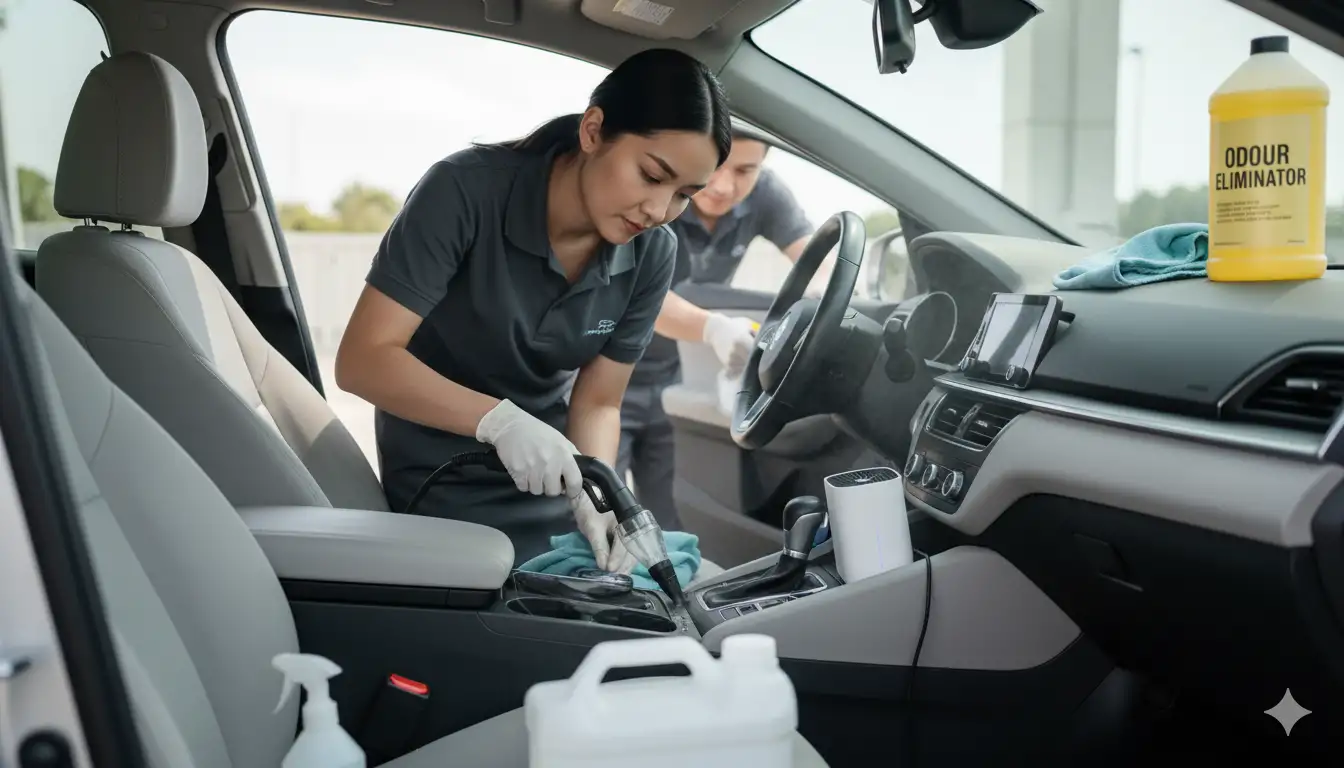
Step 3: Address the Ventilation System
The HVAC system continuously circulates trapped smoke particles unless properly cleaned. Neglecting this step guarantees odor return, regardless of interior cleaning success.
Replace Cabin Air Filter Smoke Smell
A contaminated cabin filter acts as a smoke odor reservoir, recontaminating cleaned air. Filters cost $15-40 and take 10-30 minutes to replace, making this the most cost-effective step in smoke odor removal. According to Autvex’s maintenance guide, smoke-exposed filters should be replaced immediately.
Filter replacement process:
- Locate filter (usually behind glove box or under hood)
- Remove access panel or glove box
- Note airflow direction arrow on old filter
- Install new filter matching arrow direction
- Spray new filter with odor neutralizer before installing
Consider upgrading to activated carbon filters that provide ongoing odor absorption.
Clean Car Air Conditioning System Smoke Smell
The evaporator core and ductwork harbor concentrated smoke residue that standard cleaning can’t reach. Professional HVAC cleaning foam penetrates deep into the system, breaking down deposits while killing odor-causing bacteria.
System cleaning procedure:
- Start engine and set AC to maximum cooling
- Set to recirculation mode
- Locate evaporator drain tube under vehicle
- Insert foam applicator into drain or blower intake
- Inject entire can of cleaner (follow product instructions)
- Run system for 10 minutes
- Turn off and let sit for 30 minutes
- Run on fresh air mode to dry
This process costs $20-30 DIY versus $150-200 professional service.
Car Vent Cleaning Smoke Odor
Dashboard vents accumulate visible tar buildup that releases odor when air flows through. Clean these thoroughly to prevent recontamination of treated interior air.
Detailed vent cleaning:
- Use compressed air to blow out loose particles
- Spray enzymatic cleaner into each vent
- Insert foam brush to scrub vent slats
- Use detailing brushes for deep channels
- Wipe with microfiber cloth dampened with vinegar
- Apply odor-neutralizing spray as final step
Cleaning Vents to Remove Smoke Smell
For comprehensive vent system cleaning, remove vent covers when possible. This allows access to ductwork where tar accumulates. Soak removable vents in hot water with dish soap and vinegar for 30 minutes, then scrub with a bottle brush.
For non-removable vents:
- Use flexible duct brushes to reach deep areas
- Spray disinfectant to kill bacteria
- Follow with compressed air to dry
- Install vent air fresheners for ongoing control
Step 4: Professional and Chemical Solutions
When DIY methods prove insufficient, professional-grade treatments offer definitive solutions. These require investment but guarantee results for severe contamination.
Ozone Generator for Smoke Removal Car
Ozone (O₃) generators produce unstable oxygen molecules that break down smoke compounds at the molecular level. This process, called oxidation, permanently destroys odor-causing particles rather than masking them. Professional detailers report 95-99% odor elimination with proper ozone treatment[6].
Ozone treatment specifications:
- Output required: 3,500-10,000 mg/hour for cars
- Treatment duration: 2-4 hours for moderate odor
- Safety requirement: Unoccupied vehicle only
- Ventilation period: 30-60 minutes post-treatment
Consumer generators cost $50-150, while professional units run $300-1,000.
Cost of Ozone Treatment for Car Smoke Smell
Professional ozone treatment pricing varies by severity and location:
| Service Level | Duration | Cost Range | Success Rate |
|---|---|---|---|
| Light odor | 1-2 hours | $75-100 | 90% |
| Moderate odor | 2-4 hours | $100-200 | 95% |
| Heavy contamination | 4-6 hours | $200-300 | 98% |
| Severe/multi-treatment | 8+ hours | $300-500 | 99% |
DIY ozone rental costs $40-60 per day, offering significant savings for those comfortable with the process.
Smoke Bomb Car Odor Eliminator
Chlorine dioxide “smoke bombs” release gas that penetrates all interior spaces simultaneously. These products offer professional-grade treatment in consumer-friendly packaging, costing $15-25 per application.
Application process:
- Clean interior thoroughly first
- Start vehicle and run AC on recirculation
- Activate bomb according to instructions
- Exit immediately and seal vehicle
- Leave for 4-24 hours (per product specs)
- Ventilate thoroughly before entering
- Wipe residue from surfaces
Success rate approaches 85-90% for single treatments.
Fogger Machine for Car Odor Removal
Thermal foggers disperse microscopic deodorizer droplets that match smoke particle size, ensuring penetration into the same areas smoke reached. Professional foggers heat solution to 400°F, creating a dry fog that won’t damage electronics or leave residue.
Fogger advantages:
- Reaches impossible-to-clean areas
- No moisture damage risk
- Single treatment effectiveness
- Safe for all interior materials
Rental costs $50-75 per day; professional service runs $150-250.
Enzyme Cleaner for Car Smoke Residue
Enzymatic cleaners contain living bacteria that consume organic smoke residue, converting it to carbon dioxide and water. These provide ongoing odor elimination for days after application, particularly effective on organic materials like leather and fabric.
Best enzyme products feature:
- Multiple bacteria strains
- Minimum 100 million CFU/ml concentration
- pH neutral formulation
- Extended activity period (7-14 days)
Apply liberally to all surfaces, maintaining moisture for maximum bacterial activity.
Professional Steam Cleaning Car Interior
Commercial steam cleaners generate 290°F pressurized vapor that simultaneously cleans and sanitizes. This temperature instantly breaks down tar compounds while killing 99.9% of odor-causing bacteria without chemicals[7].
Professional steam cleaning for luxury vehicles typically includes:
- Complete interior disassembly access
- 3-4 hour treatment duration
- Specialized fabric protection
- Leather conditioning post-treatment
- Warranty on odor elimination
Costs range from $200-400 but provide guaranteed results with no chemical residue.
Time and Effectiveness Considerations
Understanding treatment timelines helps set realistic expectations and plan the odor removal process effectively.
How Long Does It Take to Get Smoke Smell Out of a Car?
Complete smoke odor elimination timeframe depends on contamination severity and methods used:
Light odor (occasional smoking, <6 months):
- DIY methods: 2-3 days
- Professional treatment: 4-6 hours
- Success rate: 85-90%
Moderate odor (regular smoking, 6-12 months):
- DIY methods: 5-7 days
- Professional treatment: 1-2 days
- Success rate: 90-95%
Heavy contamination (daily smoking, >12 months):
- DIY methods: 2-3 weeks with multiple treatments
- Professional treatment: 2-3 days
- Success rate: 95-99%
Initial improvement occurs within hours, but complete molecular breakdown requires time.
Does Smoke Smell Ever Completely Go Away from a Car?
Yes, smoke smell can be 100% eliminated with proper treatment, contrary to popular belief. The key lies in addressing all contamination sources rather than just surface cleaning. Professional detailers achieve complete elimination in 95% of cases, with the remaining 5% requiring component replacement[8].
Factors affecting permanent removal:
- Treatment thoroughness and method selection
- Contamination duration and intensity
- Material types in vehicle interior
- Environmental conditions during treatment
- Follow-up maintenance performed
Vehicles smoked in for over five years may require seat foam or headliner replacement for complete elimination.
Time Required for Ozone Treatment to Work
Ozone treatment follows a predictable timeline:
During treatment (0-4 hours):
- First 30 minutes: Surface odor neutralization
- 1-2 hours: Fabric penetration begins
- 2-4 hours: Deep material treatment
- 4+ hours: Complete molecular breakdown
Post-treatment period:
- Immediate: 70-80% odor reduction
- 24 hours: 85-90% reduction
- 48-72 hours: 95-99% elimination
- 1 week: Residual breakdown complete
Multiple treatments may be needed for severe contamination, spaced 48 hours apart.
Summary
Permanently removing smoke smell requires systematic treatment of all contamination sources—from surface residue to embedded particles in ventilation systems—using a combination of deep cleaning, odor neutralization, and professional treatments when necessary.
Final Recommendations
Start with thorough vacuuming and surface cleaning, then apply baking soda overnight. Replace your cabin air filter and clean vents. If smell persists after DIY methods, invest in professional ozone treatment for guaranteed results. Remember that masking odors with air fresheners never provides permanent solutions.
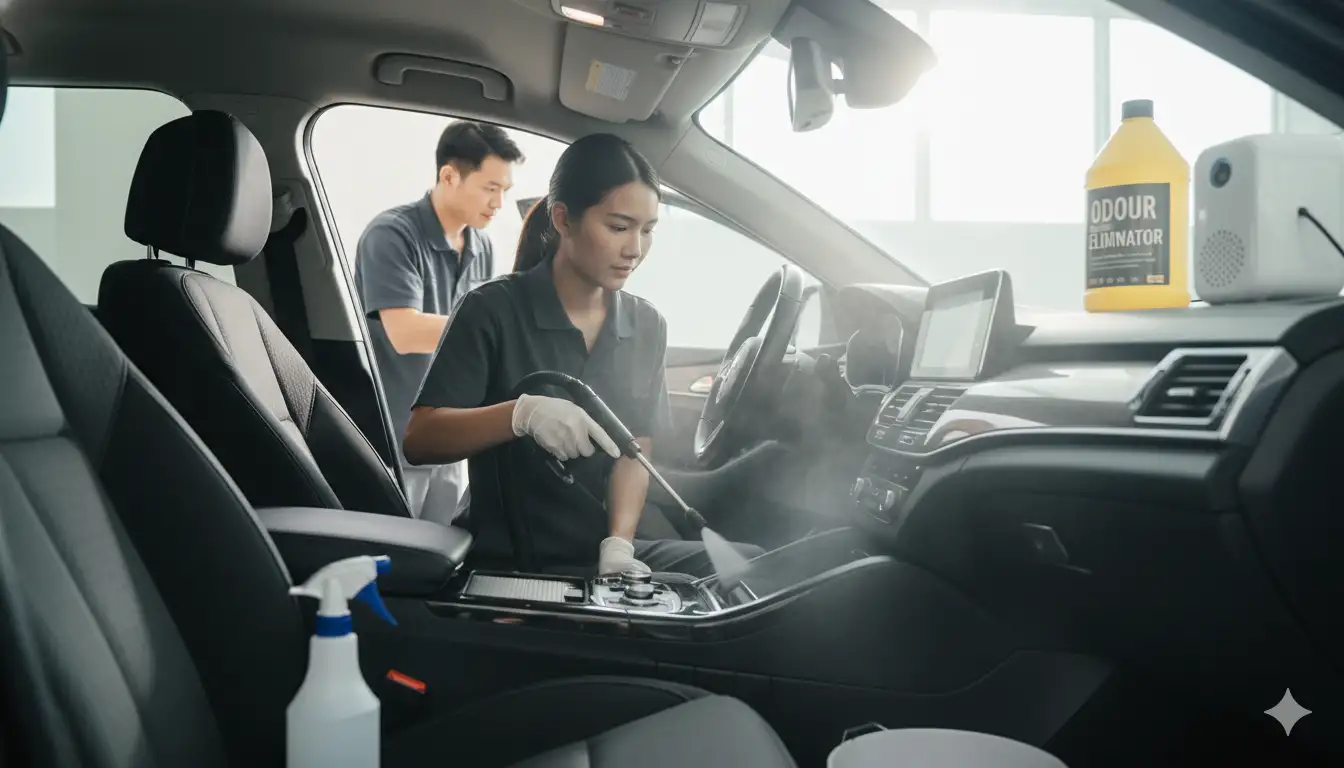
Key Takeaways
- Smoke particles hide in headliners, vents, and cabin filters requiring comprehensive treatment
- Baking soda and vinegar neutralize odors rather than masking them temporarily
- Replace cabin air filter immediately to prevent recontamination ($15-40 investment)
- Ozone treatment offers 95-99% success rate for permanent odor elimination
- Professional treatment costs $100-300 but guarantees results for severe contamination
- DIY methods take 2-7 days while professional service completes in hours
- Complete elimination is possible with proper treatment addressing all contamination sources
Decision Path / Next Steps
- For Light Smoke Odor (Occasional exposure): Begin with DIY baking soda and vinegar treatment over a weekend. Clean all surfaces, replace cabin filter, and use coffee grounds for ongoing absorption. Total cost: $30-50. Timeline: 2-3 days.
- For Moderate Contamination (Regular smoking <1 year): Combine deep cleaning with rental ozone generator. Shampoo all fabrics, steam clean if possible, then run ozone for 4 hours. Follow with charcoal bags for maintenance. Total cost: $75-150. Timeline: 3-5 days.
- For Heavy Smoke Damage (Daily smoking >1 year): Invest in professional detailing with ozone treatment. While costlier at $200-400, this ensures complete elimination and saves time. Consider having window tinting added to protect cleaned interior from UV damage.
- For Used Car Purchases: Negotiate price reduction based on treatment costs, then immediately perform full professional treatment. Factor $300-500 for complete odor elimination when evaluating purchase decisions.
- Maintenance After Treatment: Keep activated charcoal bags in vehicle, avoid smoking inside, and perform quarterly vent cleaning to prevent odor return. Regular AC system maintenanc] prevents bacteria growth that can mimic smoke odors.
FAQs
What is the best way to get rid of a smoke smell in a car?
A combination of deep cleaning, baking soda treatment overnight, cabin air filter replacement, and ozone treatment provides the most effective permanent smoke odor removal.
Does baking soda really work to remove smoke smell from car seats?
Yes, baking soda absorbs odor molecules when left on fabric seats for 12-24 hours, then vacuumed. Multiple applications may be needed for heavy smoke damage.
How much does professional ozone treatment for car smoke removal cost?
Professional ozone treatment typically costs $100-$300 depending on vehicle size and odor severity, with most treatments taking 2-4 hours.
Can I use a household ozone generator in my car?
Yes, but follow safety protocols: run it in a ventilated area, remove people and pets, and air out the vehicle for 30 minutes after treatment.
How do I clean the smoke residue from the headliner and ceiling?
Gently brush the headliner with a soft-bristled brush, apply fabric cleaner sparingly with a microfiber cloth, and avoid oversaturating to prevent sagging.
Will replacing the cabin air filter remove the smoke smell?
Replacing the cabin air filter removes trapped smoke particles and significantly reduces odor, but won’t eliminate smell absorbed in other surfaces.
How long does it take for cigarette smell to come out of a car?
With proper cleaning and treatment, most smoke odors diminish within 24-48 hours, though complete elimination may take 1-2 weeks.
Can I trade in a car that smells like smoke?
Yes, but expect reduced trade-in value of $500-$2000. Professional detailing before trade-in can minimize value loss.
Are smoke bomb odor eliminators safe to use in a car?
Yes, when used as directed. Activate with windows closed, leave for specified time, then thoroughly ventilate before driving.
What are the steps for deep cleaning a car interior with smoke damage?
Remove all items, vacuum thoroughly, clean all surfaces with appropriate cleaners, treat fabrics with baking soda, replace cabin filter, and finish with ozone treatment.
Where does the smoke smell hide in a car?
Smoke odor embeds in headliner fabric, seat cushions, carpets, air vents, cabin air filter, and porous plastics throughout the interior.
References
- Detailing Experts Canada. (2025). How to Remove Smell of Smoke from Car – Complete Guide. https://detailingexperts.ca/how-to-remove-smell-of-smoke-from-car/
- Pro Detailing Manassas. (2025). How to Get Smoke Smell Out of a Car (Permanently). https://pro-detailing.co/how-to-get-smoke-smell-out-of-a-car/
- Apex Auto Pros. (2025). How To Get Smoke Smell Out of Car. https://apexautopros.com/how-to-get-smoke-smell-out-of-car/
- BEMAC. (2024). How To Get Smoke Smell Out Of Your Car? https://www.bemac.ca/blog/how-to-get-smoke-smell-out-of-car/
- Love My Car Wash. (2025). How to Get Smoke Smell Out of Car: Effective Tips. https://lovemycarcarwash.com/how-to-get-smoke-smell-out-of-car/
- Ozonics. (2023). MICRO3 Scent-Eliminating Ozone Generator for Cars. https://ozonicshunting.com/products/micro3
- New Cars Online UK. (2023). A Guide to Removing Cigarette Odor from Your Car. https://www.newcarsonline.co.uk/blog/say-goodbye-to-that-smoke-smell-a-guide-to-removing-cigarette-odor-from-your-car/
- Fresh Layer. (2025). How To Remove Smoke Smell From Your Car. https://www.fresh-layer.com/blog/how-to-remove-smoke-smell-from-your-car

I am a senior automotive analyst at Autvex. Expert vehicle evaluations, in-depth reviews, and objective analysis helping readers make informed automotive decisions with years of industry experience.

